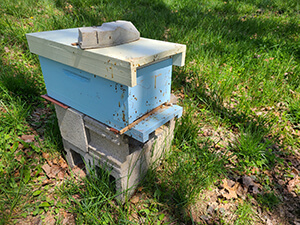
Q When not to merge bee colonies
In a recent podcast [UF/IFAS: Two Bees in a Podcast], you discussed how bee colonies can be merged without newspaper. Is there a time when you should not just throw frames together?
Howard Frysinger
Pennsylvania, May
A
I combine colonies of all types, during all times of the year, without using newspaper, spraying the bees with water or sugar water, etc. I suppose the one time I would hesitate to do it is if I wanted to keep a queen in a very weak colony (<1 frame of bees and the queen) and merge that colony with a much stronger, queenless colony. Even in that case, though, I likely would merge the colonies, but keep the queen caged in the new merged colony for 3-4 days prior to releasing her manually. In this case, my concern would be that the small colony would be unable to protect their queen in the off chance that the stronger colony tried to kill her upon merger. Caging her and manually releasing her 3-4 days later will solve this problem.
Just a quick note about manually releasing queens: I will always look at how the bees on the cage are responding to the cage prior to releasing the queen from the cage. Bees on the cage can have two main responses to the cage. First, they can be biting the cage, especially the screen mesh. When this happens, the bees are usually tightly packed on the surface of the cage, being difficult to move when brushing them lightly with your finger or hive tool. Second, they can be moving freely on the cage, not biting at the cage. In the case of the former, the bees are trying to get to the queen to kill her. She should not be released at this point. Give them another day or two to see if this behavior stops. Bees moving freely on the cage suggests the bees have accepted the queen. She can be released into the hive. I always like to pull out the frame onto which she is released. If everything looks normal (the queen is walking and the bees are not attacking her), I assume she has been accepted and I continue on my merry way.
Q Killing drones to control Varroa
Is it good practice to kill drone cells to help control Varroa destructor?
Dan Bermingham
May
A
Thanks for your question. I think killing drone cells haphazardly will not do much good in the battle against Varroa. However, there are strategic ways to kill drones, and the Varroa that invade their cells, via a process called drone brood removal. In this process, you remove one of the ten frames from your brood chamber and replace it with a frame of drone foundation. The worker bees will construct drone cells on this foundation. The queen will lay unfertilized (drone) eggs in the cells, giving you a frame of drone brood. After all of the brood on that frame is capped, you remove the frame, freeze it for two days, and return it to the hive. Freezing the frame kills the drones and mites in the cells. Returning it to the hive allows the bees to clean out the cells, drone brood and mites. The queen then lays in the cells again, thus restarting the process. Some folks find this to be a useful method to reduce Varroa populations significantly. It does work well but it is labor intensive. This would be better than randomly killing the drone brood you see on a given frame. You can see more about drone brood removal here: https://honeybeehealthcoalition.org/varroa/ (you can also Google “Honey Bee Health Coalition Varroa” to find it). Scroll down on that website to view the video on drone brood removal.
Q Nucs, nucs, nucs
You did a presentation for my bee club and talked about using a nuc to boost your population in your production hives. I was intrigued by this idea and I am in the process of setting up my hives for this. I split out the surviving queen and moved it to another location to use as the nuc. I left the old hive to raise a queen and I let them raise two queen cells. Although I thought they had enough room, they swarmed, which I caught. Now I am not sure which hive to make the nuc (the swarm or the hive with the queen cell). In your opinion which one would you use for the nuc?
Matthew Specht
April
A
If the hive you created as a split (the one with the old queen) has grown, you can consider hiving it and making it your “hive.” You can use the swarm as the “nuc.” Then, the parent hive (which you split and then it later swarmed), can just be a second full size colony. Honestly, you can do it any way that works best for you. Any of the three could be the nuc. However, I probably would use the swarm as my nuc and make the other two hives (the original hive and the split) into full-size hives.
Q Nosema spores on equipment

Now, I would like to use those drawn frames on other hives this season. Could the high-dose formic acid fumigation have adequately reduced Nosema spore viability? A quick Google Scholar search failed to provide studies showing formic acid’s effect on beeless equipment (where stronger concentrations could be employed). A 2019 article by Burnham discusses studies that show that “small molecules” can reduce spore load. “The Hive and The Honey Bee” provided another option. I have the 2015 edition. In the chapter that you and colleagues wrote on Diseases and Pests, I found mention of “Thermal Decontamination,” 120 degrees for 24 hours. Though somewhat laborious, this is doable in a kitchen oven and a small number of frames that need decontamination. What are your thoughts?
Philip Curd
Kentucky, April
A
The image that you show is consistent with what many folks teach is a sign of Nosema infection. There are two species of Nosema in honey bees in the U.S.: N. apis and N. ceranae. Nosema apis was once the dominant species and it is the one folks associate with dysentery. In the last decade or so, N. ceranae has become the dominant Nosema species, so much so that it is much harder to find N. apis. Nosema ceranae is not associated with dysentery. For that matter, some folks question if dysentery is even a sign of infection with N. apis (some argue that no one has ever shown conclusively that Nosema causes dysentery). Thus, I do not feel it is safe to say that Nosema (either species) is the predominant issue here. Other things cause dysentery (bad food resources for example). Perhaps it is just a coincidence that there is streaking. Maybe the small hive beetle larvae were responsible for staining the outside of the hive (though it does not look like SHB larva traffic to me.) The good news is that none of this background will change my reply to your actual question. ☺
I likely would have tried to freeze the combs to kill the SHBs. I would leave them frozen for a week. After that, I would wash off/out the combs with a water hose to rinse off any dead SHBs/slime they leave behind. I get the “how can I sterilize my combs” question quite a bit. Unfortunately, there is currently no good way to do it. Folks tried radiation in the past, but that is not particularly economical, and it is not a viable option for most beekeepers. I have a colleague at UF who is looking at using weak bleach solutions to clean combs. He only tested it against viruses, but I think it would/could have the same effect on Nosema. He is analyzing the data at the moment so I would be afraid to commit to an actual method on how to do this.
In the meantime, I would wash out the combs with a hose, air dry them a week or two, and then reuse them (if it were me). We find N. ceranae spores in nearly every colony we sample … so I am not sure that using these combs, even if covered in the spores, would actually add more to a hive than are already there.
I did find (probably you saw them as well) a couple of papers on formic impact on Nosema in colonies. I list the full citations at the end of this column. Fries (1991) said: “Treatment with formic acid for control of Varroa jacobsoni, as applied in this study, does not significantly decrease the infectivity of Nosema apis spores in honey bee feces on the top bars of treated combs.”
I went and checked the “Hive and the Honey Bee” reference you noted. It was for N. apis, but it “probably” will work for N. ceranae as well. If you want, give it a try and see how it works for you. I think the real catch is getting a kitchen oven to stay right at 120° F for 24 hours without the temperature spiking and melting the combs. If all of this sounds like too much to do, cut your losses and discard your combs.
As an aside: The impact of N. ceranae on bees/colonies is up-in-the-air. I have seen folks argue vehemently both ways. My thought is that it is not good for bees and that it does harm them when spore counts get high. We have some data showing impacts on longevity (but not dysentery) in cage studies, for example. The real kicker is what to do about it when you have… .


